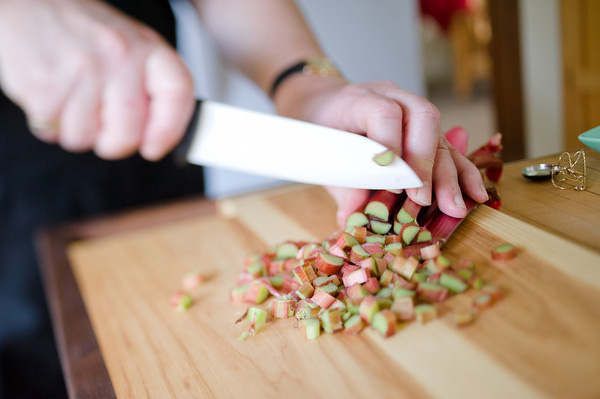
Kim Ode asserts that rhubarb is having its moment.
While this might be a convenient position for a person with a newly released book called Rhubarb Renaissance (MNHS Press, $16.95), it’s also one that sustains scrutiny — not only is rhubarb gloriously in season at the moment, it’s having a resurgence on the menus of Upper Midwestern restaurants that are scanning their own backyards for ingredients with a connection to the local landscape.
Just two examples: On a recent visit to The Bachelor Farmer, we enjoyed the bright bite of pickled rhubarb in a dish of roasted pork belly, sunny side up pheasant egg, and pea shoots; and The Black Forest Inn is featuring an asparagus and rhubarb strudel as part of its Spargelfest menu [PDF].
“Chefs are looking across the horizon and asking, ‘What aren’t we using?'” says Ode, who is also the author of Baking With the St. Paul Bread Club and a features writer for the Star Tribune. “And local local, of course — there are things we’ve discarded here, in Minnesota, as too homely and corny.” “Bebop-a-rebop, rhubarb pie,” she adds, a convenient musical shorthand for the tart vegetable’s humble status.
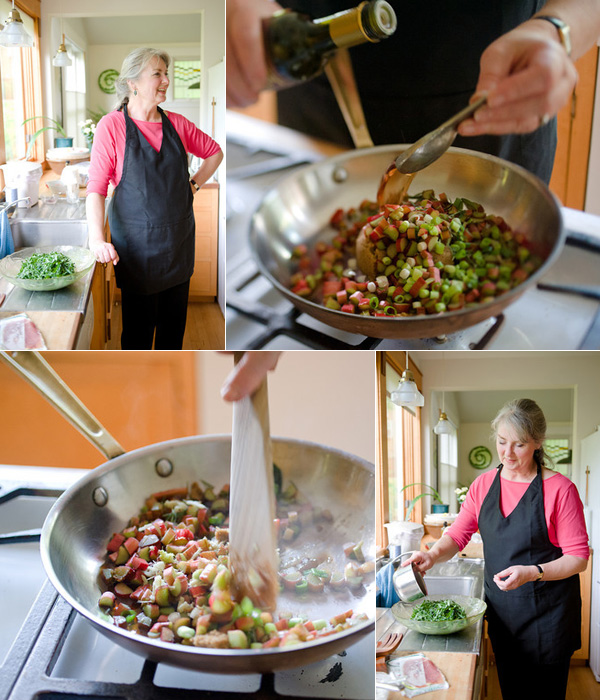
We recently joined Ode and her husband, woodworker and photographer John Danicic, in their Morningside home for a five-course meal of rhubarb. A rhubarb feast may sound at first hearing like an awful lot of the fibrous red stuff, but it really wasn’t — the meal had a sense of flow, progress, and even drama. And therein lies the story.
We kicked off our meal in the kitchen, with a prosecco cocktail spiked with a sweet / tart rhubarb base, and noshed upon rows of gorgeous crostini with goat cheese, prosciutto, and rhubarb chutney.
“Rhubarb is just such a good foundation for a chutney,” Ode says. “With a lot of chutneys, there’s so much going on that it just becomes … a chutney. You can’t identify it as a, say, blueberry chutney. So the first time I did it, I completely lost the rhubarb. So I bumped it up.”
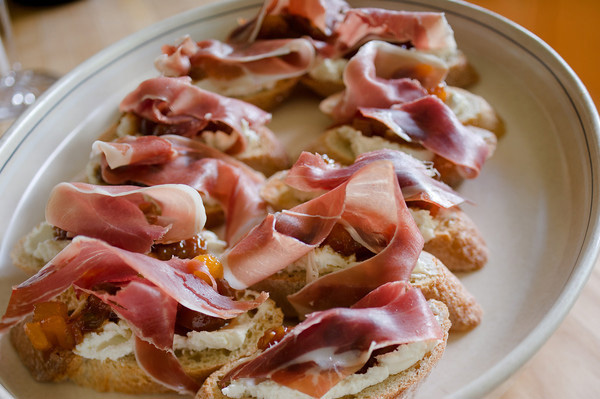
The result is a talented supporting player on a stage filled with stars: “There are your chutney flavors, a little goat cheese and cream cheese combined to take a bit of the edge off the goat, and then prosciutto because… it’s prosciutto,” Ode says. (She then points out that the stuff she’s using is made in Iowa, by La Quercia.)
Like the rest of the elegant-with-a-twist recipes in Rhubarb Renaissance, the crostini were simple to assemble, and had an admirable sense of balance. They were creamy and crunchy, bright and salty — flavors and textures pulling at one another but ultimately in harmony. That rhubarb can be both savory and multidimensional may come as a surprise to some readers, but that idea is really at the heart of Ode’s book; while Rhubarb Renaissance features dessert recipes (including one of the best sweet-tart crisps we’ve tried in years), desserts are somewhat beside the point.
Ode recalls: “When [Minnesota Historical Society Press] said: ‘Can you do rhubarb?’ I said ‘I know rhubarb.’ Then they said: ‘Well, what we’d really like to do is explore the savory side.’ And I said: ‘What savory side?’ That’s where it took my out of the church cookbook upbringing and caused me to ask: “Well, what can you do with it?'”
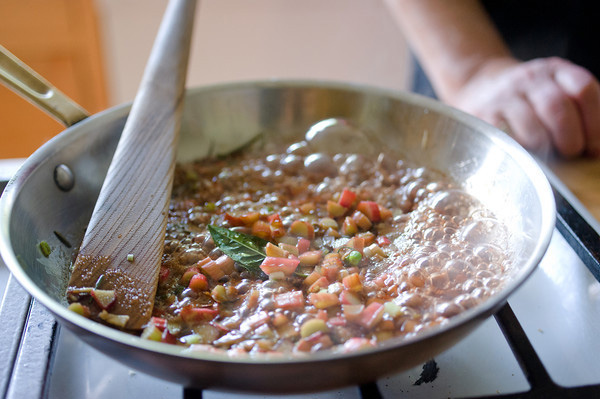
Here are a few of the recipes from the book that illustrate what you can do with it:
Spiced Rhubarb-Squash Ravioli
Good Medicine Lettuce Wraps
Halibut Skewers with Mango-Rhubarb Salsa
and Shrimp in Kimonos
These last items were one of the reasons I felt personally motivated to explore and review Ode’s book, so when the wok came out and Ode began enrobing shrimp with wonton wrappers and scoops of a savory rhubarb compote, I got the distinct feeling that I was in the right place at the right time.
Shrimp in Kimonos are absurdly fun, a novelty dish that tastes delicious: Fried in canola until crisp, the wonton wrappers contain a symphony of flavor that draws up the seafood’s natural sweetness and the rhubarb’s compensatory brightness, with the crunch of the fried wrapper rebounding off the tenderness of the shrimp.
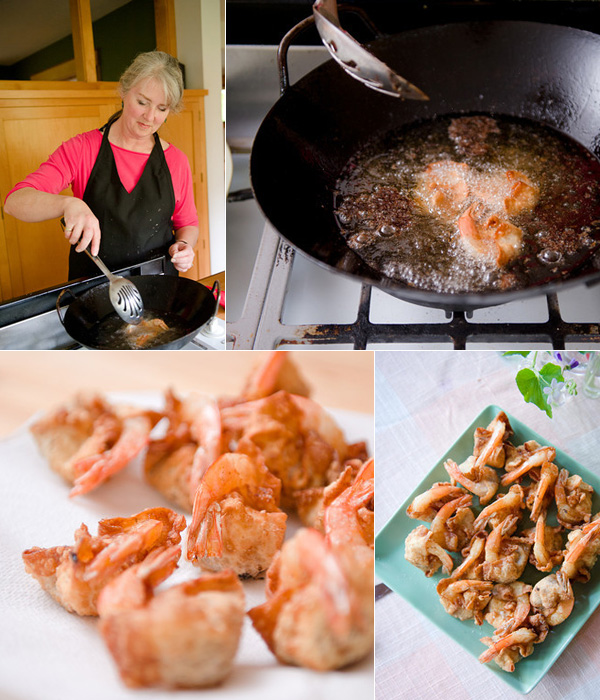
“I had seen a recipe for wonton-wrapped shrimp, and that was all they were, shrimp wrapped in wontons, served with a sauce,” says Ode. “I had discovered — it was kind of intuition — that sweet seafood would complement a tart ingredient. Lemon and fish. So then the question was, what kind of compote you want to come up with.”
“I wanted to do some herbs with this one: rosemary, and ginger because ginger and rhubarb are just good … I fiddled with that. It was one of those recipes that we hit it on the first time.”
“You changed the shrimp size,” corrects her husband, John.
Ode nods. “You find the right-sized shrimp that works with the proportions of a wonton wrapper,” she says. That turned out to be 20- to 25-count shrimp, smaller than the Costco behemoths Ode had originally tried.
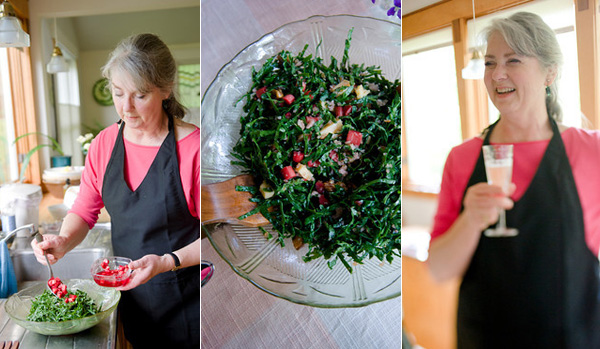
Along with the shrimp, which were substantial without being heavy, dinner includes a remarkably balanced (again, that word, but that’s the key here) and light-on-its feet salad of confetti-ed kale, rhubarb, and candied walnuts and a showstopping dessert: rhubarb meringue tassies. Ode describes them in her book as “a perfect exclamation point to a summer meal on the porch,” and that’s how we found them, too.
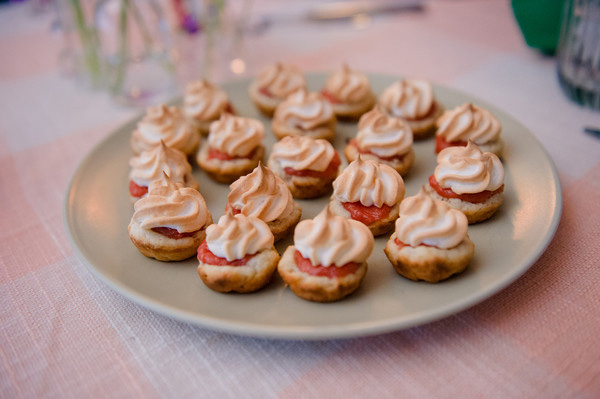
The tassies are just the thing to inspire awe in a dinner guest: They present themselves with martial flair, a platoon of tiny cups shaped from cream cheese crust filled with rhubarb curd and wearing perfect miniature helmets shaped from meringue.
It’s no coincidence that we didn’t end the meal with a classic strawberry-rhubarb pie — Ode struggled with that classic pairing as she sought to write a book that took rhubarb in a new direction.
“My initial impulse was to put my foot down and make it a strawberry-free book,” she recalls. “But I was persuaded that I should have one recipe in there because people were going to go to the index and ‘riffriffriff’ look for strawberry-rhubarb. So there is a recipe for strawberry rhubarb pie in there, but because strawberries take to balsamic vinegar so well, there’s a big dose of balsamic in there which kind of savories it a bit.”
When asked what sort of reader she’d written the book for, Ode pauses, and then replies: “I wrote it for my generation and the one below me that has grown up with rhubarb as cobblers and crisps, but have discovered that there are other ways to treat food. I wanted to surprise people who think they know about rhubarb.
“People will go: ‘Wow, I’ve never had rhubarb like this.'”
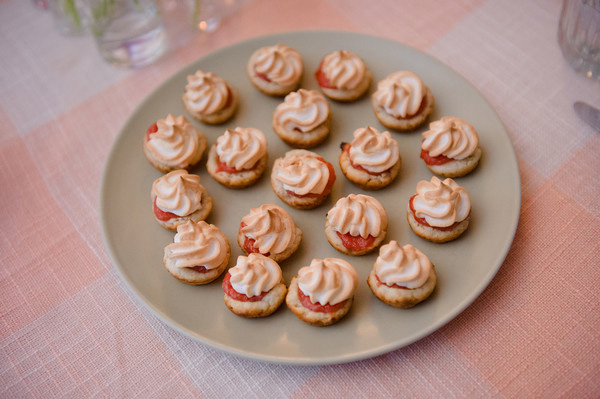
Kim Ode will host a lightly catered conversation featuring herself and authors Brett Laidlaw (Trout Caviar: Recipes from a Northern Forager) and Beth Dooley (The Northern Heartland Kitchen) next month. It takes place Monday, June 18, from 7-8 pm in the Barnes & Noble Galleria Store, 3225 W. 69th St. in Edina.
Rhubarb Meringue Tassies
from Rhubarb Renaissance by Kim Ode
These bite-size treats need to be baked the same day you plan to serve them, although the curd and dough can be made several days ahead of time. The results provide a perfect exclamation point to a summer meal on the porch. You’ll need a mini-muffin pan for these cookies. Makes 24 cookies.
Crust:
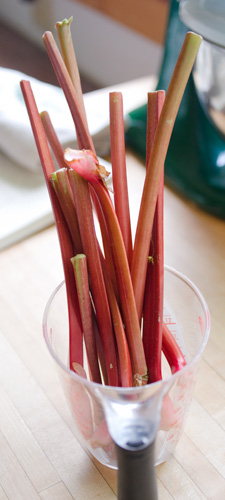
1 ¼ cups flour
1 tablespoon sugar
pinch salt
8 tablespoons (1 stick) cold unsalted butter, cut in small pieces
4 ounces cold cream cheese, cut in small pieces
1 recipe Rhubarb Curd (below)
In a large bowl, whisk together the flour, sugar, and salt. With a pastry blender or your fingers, work the butter into the flour until the butter is evenly distributed in pea-sized clumps. Add the cream cheese and continue to mix the dough until it begins to come together in a mass. Knead in the bowl, squeezing and pressing until you have a ball of dough. Turn out onto a counter and press into a thick disk. Wrap in plastic wrap and refrigerate for at least an hour and up to 2 days.
To make the tassies, preheat the oven to 350 degrees. Remove the dough from the refrigerator. Cut or pinch off a piece of dough about the size of a large grape and roll it into a ball. Press the dough into a mini-muffin cup, making sure the bottom isn’t too thin and shaping the sides so they’re level with the pan. Fill each cup with about 1 teaspoon rhubarb curd. Bake for 15 to 20 minutes, or until the pastry is golden and firm around the edges.
While the tassies are baking, make the meringue.
Meringue:
2 egg whites
½ teaspoon cream of tartar
pinch salt
½ cup sugar
¼ teaspoon vanilla
In bowl of a standing mixer, beat egg whites, cream of tartar, and salt on medium-high speed until frothy and the beater begins to leave a path. Begin adding sugar one spoonful at a time, slowly but steadily, until meringue holds a stiff peak when beaters are lifted. Add vanilla and mix until just combined.
After the tassies are baked, reduce the oven heat to 325 degrees. Top each warm tassie with a dollop of meringue or use a pastry bag to pipe a swirl onto each cookie. Bake for 10 minutes, or until meringue begins to color and set. Using a fork, carefully lift each tassie and place it on a wire rack to cool. Serve at once, or refrigerate the tassies until serving time.
Rhubarb Curd:
Like the more traditional lemon curd, this rhubarb variation can be used in a variety of ways. It’s great on warm scones or toast or dolloped alongside a slice of angel food cake or on a bowlful of fresh strawberries. But if you want to fuss a bit, it’s fabulous spread between crepes for a stacked cake or used to fill bite-size rhubarb tassies. Those recipes follow. Makes about 1 ½ cups.
2 ½ cups rhubarb, cut in half-inch pieces
⅓ cup plus ½ cup sugar, divided
⅓ cup cranberry juice
4 egg yolks
pinch salt
2 tablespoons unsalted butter, cut in four pieces
Combine rhubarb, ⅓ cup sugar, and cranberry juice in a saucepan and cook over medium heat, stirring frequently, until rhubarb breaks down into a sauce, about 10 minutes. Set aside.
Bring about 2 inches of water to a boil in a saucepan over which a medium bowl will fit. While the water is heating, whisk together the egg yolks, remaining ½ cup sugar, and salt in a medium bowl. Reduce heat to keep the water at a simmer and place the bowl over the saucepan, whisking constantly until the yolk mixture begins to thicken.
When the yolks are quite warm, whisk in the rhubarb mixture, stirring constantly until the mixture thickens. Add the butter a piece at a time, mixing well, then set aside to cool. Refrigerate for up to a week.
